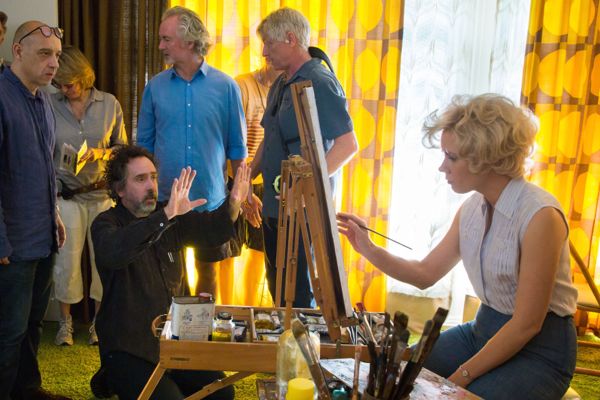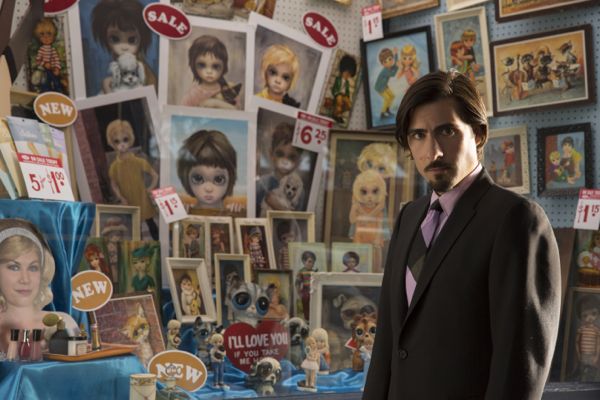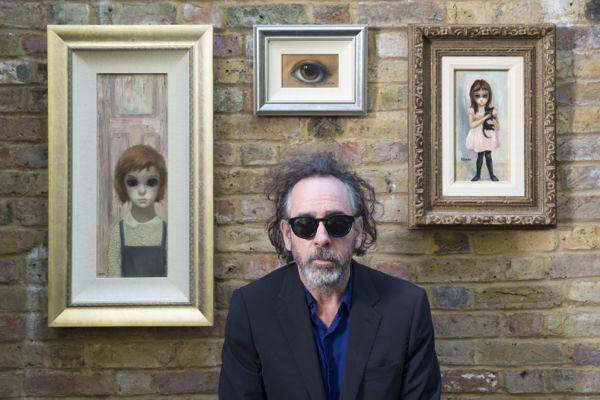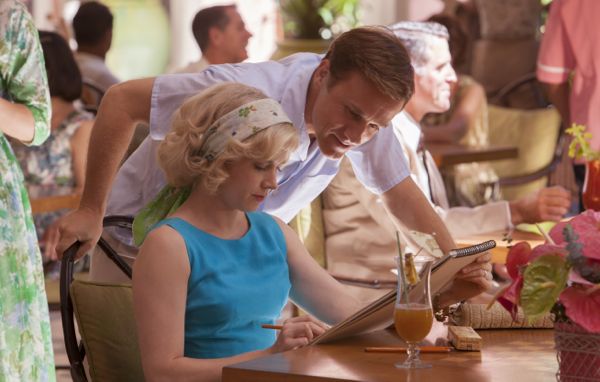Golden Globe Winner Amy Adams Talks 'Big Eyes" Movie
- Details
- Category: Interviews
- Created: Monday, 22 December 2014 10:14
- Published: Monday, 12 January 2015 03:30
- Written by Lupe R Haas

Tim Burton leaves the fantasy behind to tell the true story of painter Margaret Keane in the biographical drama centering on her work which was fraudulently claimed by her husband in the 1950s and 1960s. Burton, a long-time fan of her depictions of sad, doe-eyed children, tells the story of the tumultuous relationship, which resulted in a nasty divorce trial in which Walter Keane insisted he was the artist behind the oil paintings. Tim Burton cast Amy Adams as Margaret, Christoph Waltz as her husband and Jason Schwartzman for the dramatic roles, and the stars and director are talking about the drama which opens December 24th in this Q&A.
Q: Tim, you were originally only going to produce ‘Big Eyes,’ and (screenwriters) Scott Alexander and Larry Karaszewski were going to direct it. So how did you become involved in directing the film?
Tim Burton: We were on parallel universes, because I didn’t know Scott and Larry were writing the script. Then I met someone who had told me about this story. I knew about Keane’s work, because I grew up with it, but I didn’t know the real story. But I later met Margaret once when I was in San Francisco, and commissioned a painting from her. Then a few years later Scott and Larry approached me about producing the film.
Q: Tim, what did you see in these actors when you were casting the film?
Tim: Well, obviously they’re great actors, and they all fit. Christoph’s Walter, and Amy’s Margaret, and there was a fresh energy for me to work with new people. Everybody’s been getting sick of the people I have been working with. (laughs)
Q: What did everyone think of Margaret’s paintings when you first saw them?
Tim: Well, I grew up with her art, and it was very present. It’s suburban art, so it was in living rooms, doctors’ offices and waiting rooms. It was culturally very present at the time. I like things I find fascinating, and these paintings are like big brother watching you with their big eyes. There’s a polarized response to it; some people love it, and others wanted to rip it off the walls. I find that response fascinating.
Q: Christoph, what was the process like of trying to make Walter likable, instead of just appearing to be a total sociopath?
Christoph Waltz: What’s not to be liked? (laughs) If he wasn’t at least somewhat likable, you wouldn’t have a story. Why would Margaret hook up with an unlikable character? The story also asks you to participate, in one way or another, of the development of their relationship. The relationship only makes sense when you in some way can identify with them. If you have an unlikable person, why would you want to identify with, or relate to, their story? What would you think about Margaret if she was with an unlikable person?
Amy Adams: I think he had a very sociopathic tendency within him later in life. But I don’t think when we first met him, he was a sociopath; it just developed in him.
Christoph: The pressure of market economy is something that brings out the worst in all of us.
Q: Amy, what was it like playing such a subtle character in this film, especially since the last time audiences saw you was in ‘American Hustle,’ which was so crazy and wild? Was that part of the appeal of taking on the role of Margaret?
Amy: Yes, in some ways. But I didn’t really think about her as being really a subtle person; I always thought of her as Margaret. It wasn’t like I was aiming to portray a thing; I was trying to portray a person. She’s a very internal, so I wanted to play her as being a person.
Q: Jason, how did you get into the mindset of playing the snooty art critic and gallery owner?
Jason Schwartzman: Well, I’ve been waiting to play a role like this. (laughs) There are so many different people who work in the art world. But the gallery owners represent what’s going to be sold, and how much things cost. So it was a fun character to play.
Q: Amy, can you talk about the challenges of playing this woman who the audience meets as she’s leaving with her young daughter from her first controlling husband, and then she goes right into a psychologically captive relationship with Walter?
Amy: I think it’s unfortunately very common. Part of psychological abuse in relationships is that they’re very isolating and controlling, and very soon you feel very complicit to whatever that abuse is. In Margaret’s case, it was a lie that she chose to be a part of during those 10 years. To this day, she still gives Walter credit; she says that she wouldn’t have the following that she does today, if he didn’t take credit for the paintings. She says he was a genius at what he did.
I kept her from feeling like a victim on screen, because I didn’t want her to seem like a victim. But when you still talk to her today about it, she still gives Walter credit. She takes responsibility for what she did, but she also feels guilty that Walter ended up the way she did. She says, “Well, maybe if I didn’t lie, he wouldn’t have turned out the way he did.” She really feels badly, and I liked her sense of ownership in the deception.Q: Had you met Margaret before you began working on the film?
Amy: I knew about her art before I signed on to play her, and then I met her a few weeks before we started filming. I sat down with her for a day, and we talked.
Q: Tim, were you drawn to telling Margaret’s story because of the challenges you face in the film industry from it being dominated by business interests?
Tim: Yes, and that’s why I also enjoyed making ‘Ed Wood.’ It wasn’t just about what Scott and Larry wrote; to me, there’s a fine line between what’s perceived to be good and bad. I’ve been through that myself with critics, and experienced the good and bad. When you do something, you’re passionate about, whether it’s ‘Ed Wood’ or this story about the Keanes.
Margaret and Walter approached the paintings with such enthusiasm, like they were making a Michelangelo piece, just like how Ed Wood thought he was making ‘Star Wars’ when he was making ‘Plan 9 from Outer Space.’ (laughs) You understand this enthusiasm and the polarization of people’s responses to things.

Q: With ‘Big Eyes’ being set in the late 1950s and 1960s, how did you all insinuate yourselves into that generation of the beatniks and hippies? How did you approach that era, since the Keanes’ art was the anti-psychedelic of the time?
Tim: The paintings had big eyes with dilated pupils that weirdly fit into that scene.
Christoph: I appreciate that you think that all of us can’t remember that era. (laughs) I’m not an unreserved enthusiast about this art.
Amy: On another note, exploring the costumes with (designer) Colleen (Atwood) was amazing. Watching all the artistic departments is always something I enjoy when I make a film. Watching them bring this era to life, whether it be San Francisco in general or just a house, and the small details people bring in, is a beautiful and wonderful thing.
Q: It was shown in the film that Margaret became a Jehovah’s Witnesses, and continuing this con would go against her religious beliefs. Why wasn’t that aspect of her life shown more in the film?
Amy: I don’t know her exact timeline of her religious evolution exactly, but I don’t believe she was a Jehovah’s Witnesses and lying at the same time. I think her converting faiths and telling the truth happened around the same time. I think her becoming a Jehovah’s Witnesses was part of the reason why she told the truth, and why she still takes responsibility. I don’t think she’s interested in putting the blame on anyone exclusively. Of course she thinks Walter was crazy, but she does take responsibility for being a part of it.
Q: This movie is based on Margaret’s life story, and you involved her in the filmmaking process. If Walter were alive today, would you have wanted to meet with him, and if so, what would you ask him? Amy, were you able to speak with Margaret’s daughter?
Amy: Yes, Margaret and (her daughter) Jane are really close, and still very much involved in each other’s lives. They’re always together, so I did have a chance to speak with Jane. But I wouldn’t want to meet with Walter; we’d have to keep it a secret that we were making the movie.
Tim: If you ever read his autobiography, you’ll ask yourself that question. (laughs)
Christoph: Or try to read it, anyway. (laughs)
Amy: He claimed he was a good man.
Tim: In his version, he compared himself to Henry Higgins, and Maragaret was Eliza Doolittle.
Q: For Tim and Amy, as parents, what kind of life lessons do you think this movie tells? How does being a parent inform the way you make movies like this?
Tim: I don’t know if that aspect of my life has anything to do with the way I approach making this kind of film. Growing up in that era myself, and understanding the culture I grew up in, with the end of the American dream, the idea of this dysfunctional couple coming together and creating these mutant children, felt like my family. (laughs) So I approached the film in a strange way. But I will never show this movie to my children. (laughs) I’ll show them Sleepy Hollow and Sweeny Todd, but not this one. (laughs)
Amy: Being a parent actually sparked a great interest in the movie for me. I think I read the script before I was a mom, and I saw Margaret one way. After I had my daughter and have been a daughter for about four years, I see her in a totally different way now.
I understood this flawed parent, because I definitely feel like one. Being an artist and a mom sometimes keeps you at odds. Not to say you can’t do both, but an artist’s life can feel very isolating and narcissistic. Being a parent means something completely different. So I understood Margaret trying to make the right decisions, and the difficulties of lying to your child. That’s something I found very interesting. I was very interested in that dynamic. When Margaret was asked what she wanted people to walk away with from the movie. She said, “Stand up for yourself, be true to yourself, read your Bible and don’t lie.”
Q: Tim, this movie isn’t visually like many of your previous films, including the colors. What choices did you make in order to have the movie look the way it did?
Tim: It was a combination of things. First off, you have the time and era, as well as the paintings, which suggest something. The weird color schemes helped create their vibe. Also, the story and relationship between Margaret and Walter started to feel slightly like the films of the early 1960s, including those made by Hitchcock.
CW: I was there every day; I can prove without a reasonable doubt that it is a Tim Burton movie. (laughs)
Q: The film shows there was a struggle between the abstract art and realistic art. Where are all of you in this struggle, and where do you stand?
Tim: Again, people’s perception of art is an interesting thing; either it speaks to you, or it doesn’t. I think the reason the story flew under the radar is because most people and critics didn’t really consider it art. So it didn’t hit the major headlines, and was instead in the back pages of a small Honolulu paper.
From the beginning of my career, I myself have experienced people loving and hating my work. Some people would say, “This film is so much lighter,” while other people would say the same movie was “so much darker.” How can some people view art as being light, while others see it as being very dark? So people’s perceptions of things were fascinating. I think this story is a perfect example of that question, which is unanswerable.
I was also drawn to this story because I love and hate the art. Why would grown people have images of children hanging in their living rooms?
Q: It seems like Margaret has ever-changing views of feminine values, She starts off by leaving her first husband, clearly feeling like she deserves more, especially when she goes on the job interviews. Then her life spirals down again when she begins the scheme with Walter. Amy, do you think she related to feminist values by the end of the film?
Amy: Well, Margaret wasn’t part of movements. As she puts it, she was just in closets, making paintings. I like how Larry and Scott brought that into the movie. I do think that whether it was intentional or not, she did do something that was very much of the moment, and stood up for herself. I do think that coincided with the feminist movement. But I’m not sure that she was aware she was doing it to be a voice for all women. She was probably doing it to also be a voice for the truth.
Q: For the actors, what was the experience of being directed by Tim? Was there anything that he said that was helpful in portraying your roles?
Tim: Should I leave the room so that they can speak freely? (laughs)
Christoph: It’s not that easy. (laughs) In all seriousness, when you work with Tim Burton, you’re invited to participate in whatever he does. That kept me on my toes, and that’s where I want to be.
Amy: I agree-it is all inclusive, and you are always invited to participate. I have wanted to work with Tim since I first started thinking about being an actress. Like Margaret, I’m not really great at self-promotion, and I usually stutter when I meet people I want to work with. Luckily that worked with Tim. (laughs) I actually wrote him a letter when I heard about this, and then sent him an email, expressing my interest in wanting to be involved. I was the most relaxed I’ve ever been on set, which I don’t think I should have been. But I felt like I was part of something bigger than just what I was playing, and that was a really great feeling.
Jason: I loved working on the film overall. But working with Tim brought an enthusiasm and excitement to the set; we were fascinated by what we were doing. We were laughing and smiling, and had a sense of enjoyment while we were shooting the movie. There was joy in every take, and that was fun to do. We were taking great pleasure in making the film, and that was wonderful.




